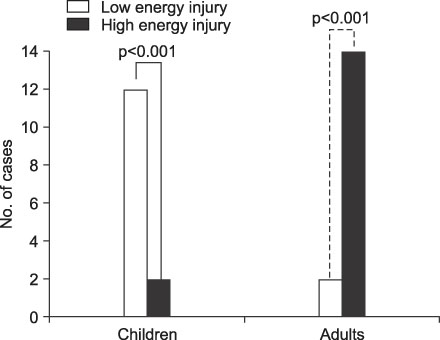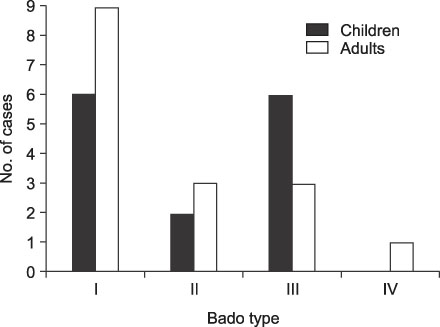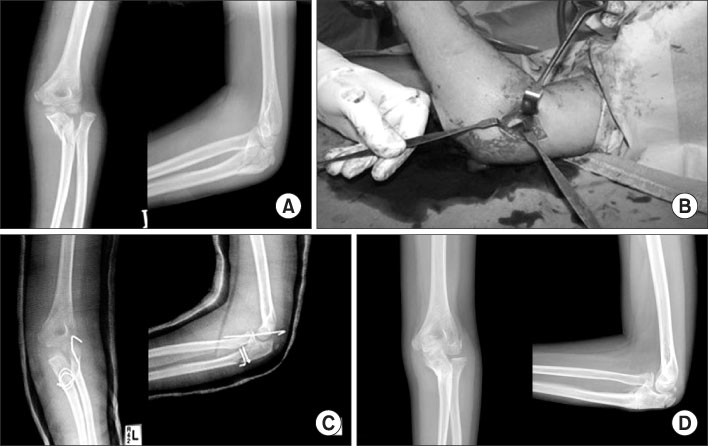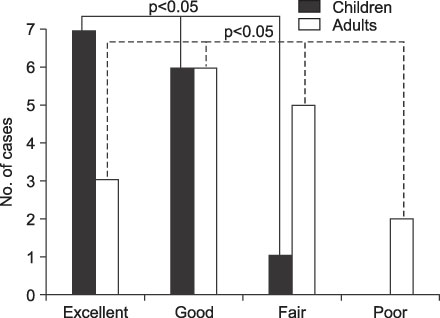J Korean Orthop Assoc.
2009 Aug;44(4):461-466.
A Comparison of Monteggia Fractures in Children and Adults
- Affiliations
-
- 1Department of Orthopaedic Surgery, Chonbuk National University Medical School, Research Institute of Clinical Medicine, Jeonju, Korea. jrkeem@chonbuk.ac.kr
Abstract
- PURPOSE
This study compares the mechanism of injury and the treatment outcomes in children and adults with Monteggia fractures. MATERIALS AND METHODS: 30 patients with Monteggia fractures were treated. There were 14 children with an average age of 8.6 years and 16 adults with an average age of 36.2 years. The results are based on a review of the clinical records and the initial radiographs combined with a follow-up examination. RESULTS: Pediatric Monteggia fractures were almost always found to be the result of low energy trauma (86%), but in adults, these fractures were most often found to be result of high energy trauma (88%). There were high prevalence of type III fractures with concomitant posterior interosseous nerve injury in the children. There were 7 serious complications in the adults. CONCLUSION: The clinical outcomes of Monteggia fracture in children were satisfactory as compared to that in adults. Yet, we recommend cautiously diagnosing and treating this injury in children because most type III fractures were accompanied by posterior interosseous nerve injury.
Keyword
Figure
Reference
-
1. Bado , JL . The Monteggia lesion. Clin Orthop Relat Res. 1967. 50:71–86.2. Eglseder WA, Zadnik M. Monteggia fractures and variants: review of distribution and nine irreducible radial head dislocations. South Med J. 2006. 99:723–727.
Article3. Konrad GG, Kundel K, Kreuz PC, Oberst M, Sudkamp NP. Monteggia fractures in adults: long-term results and prognostic factors. J Bone Joint Surg Br. 2007. 89:354–360.4. Onley BW, Menelaus MB. Monteggia and equivaleni lesions in childhood. J Pediat Orthop. 1989. 9:219–223.5. Ovesen O, Brok KE, Arreskøv J, Bellstrøm T. Monteggia lesions in children and adults: an analysis of etiology and long-term results of treatment. Orthopedics. 1990. 13:529–534.
Article6. Moon ES, Rowe SM, Ryang DH, Lee GH. A clinical study fo the monteggia lesion in children. J Korean Orthop Assoc. 1992. 27:1846–1853.7. Song KS, Lee KW. Diagnosis and treatment of monteggia fracture in children. J Korean Orthop Assoc. 2000. 35:415–420.
Article8. Bruce HE, Harvey JP Jr, Wilson JC Jr. Monteggia fractures. J Bone Joint Surg Am. 1974. 56:1563–1576.
Article9. Bryan RS. Monteggia fracture of the forearm. J Trauma. 1971. 11:992–998.
Article10. Boyd HB, Boals JC. The monteggia lesion. A riview of 159 cases. Clin Orthop Relat Res. 1969. 66:94–100.11. Morton S, Bernard D, Joel T. Posterior interosseous nerve palsy as a complication of Monteggia fractures in children. Clin Orthop Relat Res. 1968. 58:141–145.12. Spar I. A neurologic complication following Monteggia fracture. Clin Orthop Relat Res. 1977. 122:207–209.
Article13. Smith FM. Monteggia fractures. An analysis of twenty-five consecutive fresh Injuries. Surg Gynec and Obstet. 1947. 85:630–640.14. Spinner M. Posterior interosseous nerve palsy as a complication of Monteggia fracture in children. Clin Orthop Relat Res. 1968. 58:141–145.15. Wiley JJ, Pegington J, Horwich JP. Traumatic dislocation of the radius at the elbow. J Bone Joint Surg Br. 1974. 56:510–517.
Article16. Evans EM. Pronation injuries of the forearm, with special reference to the anterior Monteggia fracture. J Bone Joint Surg Br. 1949. 31:578–588.






